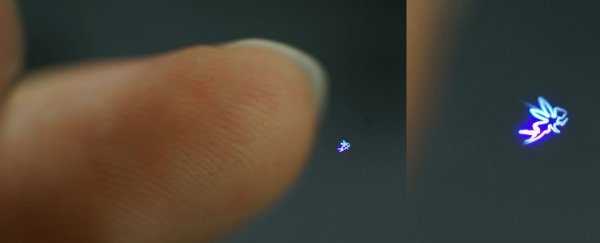Three-dimensional, interactive holograms are now a reality, thanks to researchers in Japan who have used powerful, ultra-quick lasers to produce holograms that can be physically felt and respond to human touch.
According to volunteers who have tested these interactive holograms, the mid-air mirages feel somewhere between sandpaper and a static shock. They're made using tiny points of plasma light called voxels, that are created when the focused energy of a laser ionises the surrounding air.
The lasers used by the team from the University of Tsukuba's Digital Nature Group (DNG) are special femtosecond lasers transmitting in bursts of 30 to 270 femtoseconds (1 femtosecond is a quadrillionth of a second). Combined with a spatial light modulator, a mirror, and a Galvano scanner (used to precisely target lasers), the DNG team was able to create shapes up to 1 cm cubed with a resolution of up to 200,000 dots-per-second at the highest setting.
That high speed means the holograms can respond in real-time to touches and add a level of interactivity with the help of a camera underneath, which monitors finger and hand movements. While previous experiments have achieved similar results, the DNG researchers say their study is the first to offer such a high resolution without being harmful to the human touch.
The key to preventing the lasers from burning skin was reducing the duration of the laser's bursts - the sweet spot was between 50 milliseconds and 1 second. Team leader Yoichi Ochiai says the hologram size is limited by the size of the spatial light modulator included in the setup, and he's hoping to develop this proof-of-concept further in the future.
As for how the technology could eventually be used, imagine ticking off a checklist that hangs in the air, or animals in a holographic zoo you can reach out and touch - this is all a long way down the line, but the potential is there once scientists work out how to make these holograms larger and more varied.
"The spatial light modulator [can] modify the phases of light rates and produce various spatial distributions of light based on interference," explains the team from DNG. "Our results led to calmer and safer plasma generation that can be incorporated into our daily lives."
The same technique was used to display projects in the air, across fluorescent plates, in water and in a fluorescent solution. The experiment has been submitted as part of the SIGGRAPH 2015 exhibition later this year, covering computer graphics and interactive techniques.

